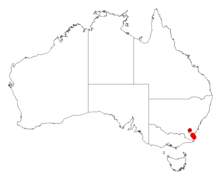Acacia georgensis
Acacia georgensis, commonly known as Bega wattle or Dr George Mountain wattle, is a species of Acacia native to southeastern Australia.[2][3] It was one of eleven species selected for the Save a Species Walk campaign in April 2016 when scientists walked 300 km to raise money for collection of seeds to be prepared and stored at the Australian PlantBank at the Australian Botanic Garden Mount Annan.[4]
| Bega wattle | |
|---|---|
| Scientific classification | |
| Kingdom: | Plantae |
| Clade: | Tracheophytes |
| Clade: | Angiosperms |
| Clade: | Eudicots |
| Clade: | Rosids |
| Order: | Fabales |
| Family: | Fabaceae |
| Clade: | Mimosoideae |
| Genus: | Acacia |
| Species: | A. georgensis |
| Binomial name | |
| Acacia georgensis | |
 | |
| Occurrence data from AVH | |
| Synonyms | |
|
Racosperma georgense (Tindale) Pedley | |
Description
The shrub or tree typically grows to a height of 2 to 10 m (6 ft 7 in to 32 ft 10 in) and can have an erect or spreading habit. The brown or grey coloured bark has a corrugated to furrowed texture that can be or deeply fissured. It has glabrous and terete branchlets that are angular but can be compressed at extremities and is usually covered in a fine white powdery coating. Like most species of Acacia it has phyllodes rather than true leaves. The evergreen phyllodes have a narrowly elliptic shape and can be sickle shaped with a length of 6 to 15 cm (2.4 to 5.9 in) and a usual width of 7 to 15 mm (0.28 to 0.59 in) but can reach up to 30 mm (1.2 in). the phyllodes have many longitudinal veins numerous that are closely spaced with three of them more prominent than the others. It blooms between August and October producing inflorescences which are found singly or in pairs in the axils and which have ovoid or cylindrical flower-heads with a length of 0.7 to 3.5 cm (0.28 to 1.38 in) packed with bright yellow flowers. Following flowering firmly papery to thinly leathery seed pods form that are flat and straight but raised over and constricted between each of the seeds. The pods have a length of 2.5 to 7 cm (0.98 to 2.76 in) and a width of 3 to 4 mm (0.12 to 0.16 in) and are scurfy and glabrous with fine hairs along the margins and longitudinally arranged seeds inside.[2]
Distribution
It has a limited range in south eastern New South Wales from around Tathra and Bega in the north and extending down the Great Dividing Range to around Bemboka, the Yowrie River and Tuross River regions in the south. It is often situated on exposed rocky outcrops, slopes and ridges growing in thin soils over sandstone, conglomerate or granite as a part of scrub, heath or open dry sclerophyll forest communities.[2]
See also
References
- Acacia georgensis, Species Profile and Threats Database, Department of the Environment and Heritage, Australia.. Retrieved 16 November 2018.
- Harden, Gwen J. (1990). "Acacia georgensis Tindale". Plantnet - New South Wales Flora Online. Royal Botanic Gardens, Sydney. Retrieved 25 April 2016.
- "Bega Wattle - profile | NSW Environment & Heritage".
- Barlass, Tim (10 April 2016). "Scientists race to save 11 endangered plants in NSW". Sydney Morning Herald.
